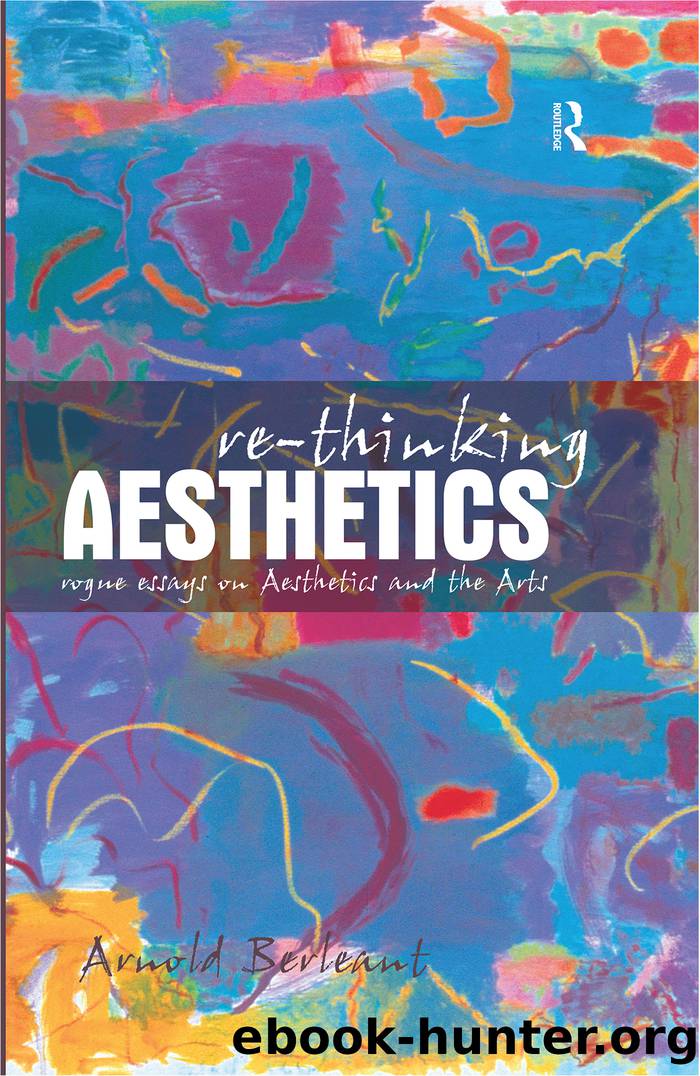Re-Thinking Aesthetics by Berleant Arnold;

Author:Berleant, Arnold;
Language: eng
Format: epub
Publisher: Taylor & Francis Group
Published: 2014-08-15T00:00:00+00:00
Aspects of Intuition
In tracing the dimensions of aesthetic intuition, it is hard to avoid falsifying the subject. The primary virtue of a theory of embodiment lies in the fact that it does not admit of separation, and it is in the failure to recognize this that most theories of art go astray. In one fashion or another, aesthetic theory has been reductive in its practice, operating by a logic of division. On the one hand, theories of art have attempted to show how art can be resolved into something more clearly understood, such as language, symbol, emotion, or verisimilitude, thus denying its distinctiveness by reducing it to a common denominator of culture. On the other hand, until recently it has been the main achievement of aesthetics to reserve art to its own special region by isolating the object and assigning to the viewer an attitude of disinterested contemplation. Thus by the tactic of keeping art cognitively distinct and aesthetically separate, both the scholar and the appreciator have sought to tame the irrepressible nature of the enterprise.
Intuition, as we shall pursue it here, suggests a way out of this arithmetic of experience, for it shows how it is impossible for art to be subdued by a tactic of reduction and division. Yet in a sense we shall unwillingly be risking a similar error. There are many uses of intuition, and in commenting on them successively, it is important to realize that many of these aspects may combine in the fullness of our experience of art. One facet of intuition does not necessarily exclude another but each suggests some aspect of the landscape of aesthetic experience. To apply a well known metaphor, aesthetic theory is a map which, by removing itself from the terrain, represents abstractly by sharp discriminations the directness and continuity of the region of experience to be travelled.
Some features of intuition pervade all its facets. One is struck by the sharpness and clarity of the experience, by the vividness with which we perceive in the realm of art. Perception may be subtle or subdued but it is never dull, unless its force is that of dullness itself, in which case it is vividly dull, emphatically and overwhelmingly dull, as in Beckettâs Waiting for Godot. Another pervasive trait of aesthetic intuition lies in its striking directness or immediacy. When art is effective, it exhibits a forthrightness from which we cannot turn aside without turning away. Artâs impact, when once it is captured, is straightforward and penetrating. Still another general aspect of aesthetic intuition lies in its character of intrinsic perception, dwelling on the properties of an object for the sake of their inherent qualities.6 Here is where the semantic theories of art go awry by assigning a mediating role to art. Art is never replaceable without being sacrificed; it is never an aesthetic means exclusively, although it may be a political or moral one. Perhaps the most useful characterization of this aspect of intuition lies in speaking of the presentational quality of art.
Download
This site does not store any files on its server. We only index and link to content provided by other sites. Please contact the content providers to delete copyright contents if any and email us, we'll remove relevant links or contents immediately.
Verus Israel: Study of the Relations Between Christians and Jews in the Roman Empire, AD 135-425 by Marcel Simon(552)
Infocracy by Byung-Chul Han(541)
Caesar Rules: The Emperor in the Changing Roman World (c. 50 BC â AD 565) by Olivier Hekster(530)
Europe, Strategy and Armed Forces by Sven Biscop Jo Coelmont(477)
Banned in the U.S.A. : A Reference Guide to Book Censorship in Schools and Public Libraries by Herbert N. Foerstel(446)
Reading Colonial Japan by Mason Michele;Lee Helen;(444)
The Roman World 44 BC-AD 180 by Martin Goodman(437)
Give Me Liberty, Seventh Edition by Foner Eric & DuVal Kathleen & McGirr Lisa(436)
DS001-THE MAN OF BRONZE by J.R.A(423)
The Dangerous Life and Ideas of Diogenes the Cynic by Jean-Manuel Roubineau(417)
The Oxford History of World War II by Richard Overy(414)
Introducing Christian Ethics by Samuel Wells and Ben Quash with Rebekah Eklund(412)
american english file 1 student book 3rd edition by Unknown(412)
Imperial Rome AD 193 - 284 by Ando Clifford(409)
Basic japanese A grammar and workbook by Unknown(392)
Literary Mathematics by Michael Gavin;(373)
Language Hacking Mandarin by Benny Lewis & Dr. Licheng Gu(352)
How to Reach the 9.0 in IELTS Academic Reading by IELTS Medical(333)
The Oxford History of the Renaissance by Campbell Gordon;(332)
